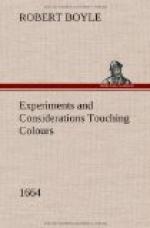5. Thirdly. But, Pyrophilus, though this be at present the Hypothesis I preferr, yet I propose it but in a General Sense, teaching only that the Beams of Light, Modify’d by the Bodies whence they are sent (Reflected or Refracted) to the Eye, produce there that Kind of Sensation, Men commonly call Colour; But whether I think this Modification of the Light to be perform’d by Mixing it with Shades, or by Varying the Proportion of the Progress and Rotation of the Cartesian Globuli Caelestes, or by some other way which I am not now to mention, I pretend not here to Declare. Much less do I pretend to Determine, or scarce so much as to Hope to know all that were requisite to be Known, to give You, or even my Self, a perfect account of the Theory of Vision and Colours, for in Order to such an undertaking I would first Know what Light is, and if it be a Body (as a Body or the Motion of a Body it seems to be) what Kind of Corpuscles for Size and Shape it consists of, with what Swiftness they move Forwards, and Whirl about their own Centres. Then I would Know the Nature of Refraction, which I take to be one of the Abstrusest things (not to explicate Plausibly, but to explicate Satisfactorily) that I have met with in Physicks; I would further Know what Kind and what Degree of Commixture of Darkness or Shades is made by Refractions or Reflections, or both, in the Superficial particles of those Bodies, that being Shin’d upon, constantly exhibit the one, for Instance, a Blew, the other a Yellow, the third a Red Colour; I would further Know why this Contemperation of Light and Shade, that is made, for Example, by the Skin of a Ripe Cherry, should exhibit a Red, and not a Green, and the Leaf of the same Tree should exhibit a Green rather than a Red; and indeed, Lastly, why since the Light that is Modify’d into these Colours consists but of Corpuscles moved against the Retina or Pith of the Optick Nerve, it should there not barely give a Stroak, but produce a Colour, whereas a Needle wounding likewise the Eye, would not produce Colour but Pain. These, and perhaps other things I should think requisite to be Known, before I should judge my Self to have fully Comprehended the True and Whole Nature of Colours; and therefore, though by making the Experiments and Reflections deliver’d in this Paper, I have endeavour’d somewhat to Lessen my Ignorance in this Matter, and think it far more Desireable to discover a Little, than to discover Nothing, yet I pretend but to make it Probable by the Experiments I mention, that some Colours may be Plausibly enough Explicated in the General by the Doctrine here propos’d; For whensoever I would Descend to the Minute and Accurate Explication of Particulars, I find my Self very Sensible of the great Obscurity of things, without excepting those which we never see but when they are Enlightned, and confess with Scaliger[5], Latet natura haec, (says he, Speaking of that of Colour) _& sicut aliarum rerum species in profundissima caligine inscitiae humanae._




